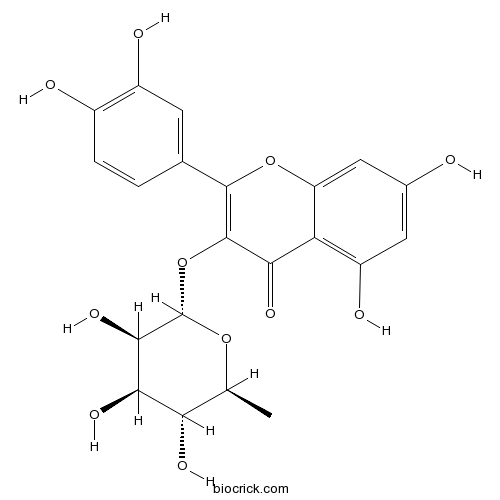A quercetin O-glycoside that is quercetin substituted by a α-L-rhamnosyl moiety at position 3 via a glycosidic linkage.
InChI=1S/C21H20O11/c1-7-15(26)17(28)18(29)21(30-7)32-20-16(27)14-12(25)5-9(22)6-13(14)31-19(20)8-2-3-10(23)11(24)4-8/h2-7,15,17-18,21-26,28-29H,1H3/t7-,15-,17+,18+,21-/m0/s1
Quercetin is a common antioxidant flavonoid found in vegetables, which is usually present in glycosylated forms, such as quercitrin (3-rhamnosylquercetin), has anti-inflammatory effect which is mediated through the inhibition of the NF-kappaB pathway, inhibits cytokine and inducible nitric oxide synthase expression through inhibition of the NF-kappaB pathway without modification of c-Jun N-terminal kinase activity (both in vitro and in vivo). [1]
Quercetin has prevention of H2O2-induced apoptosis via anti-oxidant activity and heme oxygenase 1 gene expression in macrophages. [2]
Quercitrin exhibits a scavenger and antioxidant role, and these effects probably are mediated via different mechanisms, which may involve the negative modulation of the Fenton reaction and NMDA receptor. [3]
Quercetin( 50 μM)can reduce UVB-induced cell death and apoptosis in HaCaT cells, also similarly reduce UVB-induced ROS generation and cell death in live zebrafish. [4]
Quercitrin exhibits strong antioxidant and anti-carcinogenic activities, it contributes to the inhibition of neoplastic transformation by blocking activation of the MAPK pathway and stimulation of cellular protection signaling. [5]
Quercitrin and Taxifolin can stimulate osteoblast differentiation in MC3T3-E1 cells and inhibit osteoclastogenesis in RAW 264.7 cells, shows a positive effect of these flavonoids on bone metabolism. [6]
English website: Quercitrin
Japanese website: Quercitrin
Chinese website: Quercitrin
[1] Comalada M, Camuesco D, Sierra S, et al. Eur J Immun, 2005, 35(2):584–92.
[2] Chow J M, Shen S C, Huan S K, et al. Biochem Pharmacol, 2005, 69(12):1839-51.
[3] Wagner C, Fachinetto R, Corte C L D, et al. Brain Res, 2006, 1107(1):192-8.
[4] Yang H M, Ham Y M, Yoon W J, et al. J Photoch Photobio B , 2012, 114(5):126-31.
[5] Ding M, Zhao J, Bowman L, et al. Int J Oncol, 2010, 36(1):59-67.
[6] Satué M, Arriero M D M, Monjo M, et al. Biochemical Pharmacology, 2013, 86(10):1476-1486.
[7] Li J, Wang Z W, Zhang L, et al. Biomedical Chromatography, 2008, 22(4):374-8.



